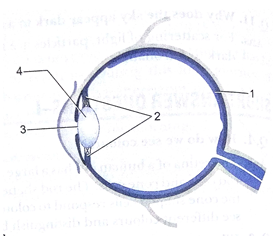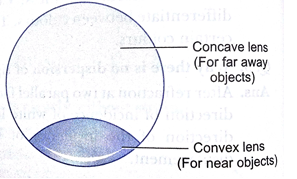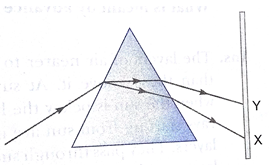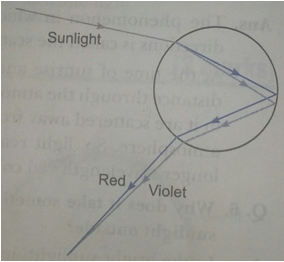Short Answer Questions - II - 3 Marks
Que 1. (a) Name the four parts labelled as 1, 2, 3 and 4 in the given diagram.
(b) At which place is the image of an object formed?

Ans. (a) 1. Retina
2. Ciliary muscles
3. Pupil
4. Crystalline lens
(b) Retina.
Que 2. What is presbyopia? What causes presbyopia? How is presbyopia corrected?
Ans. The power of accommodation of the eye decreases with ageing. For most people, the near point gradually recedes and the far point comes closer. This defect is called presbyopia.

It arises due to the gradual weakening of the ciliary muscles and diminishing flexibility of the eye lens. Such a person may suffer from myopia and hypermetropia. This defect is then corrected by using bi-focal lenses of suitable focal lengths. The upper part of the lens is concave lens which corrects myopia to see the distant objects clearly, while the lower part of the lens has convex lens which corrects the hypermetropia to see the nearby objects clearly.
Que 3. What is astigmatism? What causes astigmatism? How is astigmatism corrected?
Ans. In this defect, a person cannot focus on both horizontal as well as vertical lines at the same time. So he can see the objects clearly only in one plane. This defect is mainly due to to the cornea that is not perfectly spherical. As a result, the cornea has different curvatures in different directions of the horizontal and vertical planes. This defect can be corrected by using cylindrical lenses of suitable focal length and suitable axis in the spectacles.
Que 4. What is meant by ‘persistence of vision’? We are able to see the movie picture in a cinema hall. How does this happen?
Ans. The ability of the human eye to continue to see the image of an object for a very short duration even after the removal of that object is called persistence of vision.
It is due to persistence of vision that we are able to see movie pictures in a cinema hall. The pictures in the form of a long film are projected on the screen at a rate of about 24 pictures per second. Under these conditions, the image of one picture persists on the retina of the eye till the image of the next picture falls on the screen, and so on. Due to this, the slightly different images of the successive pictures present on the film merge smoothly with one another and give us the feeling of continuity and moving images.
Que 5. What is meant by scattering of light? Use this phenomenon to explain why the clear sky appears blue or the sun appears reddish at sunrise.
Ans. The phenomenon in which a part of the light incident on a particle is redirected in different direction is called the scattering of light.
At the time of sunrise and sunset, when the Su is near the horizon, sunlight travels a greater distance through the atmosphere to reach us. During this, most of the shorter wavelengths present in it are scattered away from our line of sight by the molecules of air and other fine particles in the atmosphere. So, light reaching us directly from the rising or setting Sun consists mainly of the longer wavelength red colour because of which the Sun appears red.
Que 6 Why does it take some time to see objects in dim room when you enter the room from bright sunlight outside?
Ans. In the bright sunlight, iris causes the pupil to become smaller so that only a small portion of light enters the eye and rods of the retina are also adjusted in the same way. But, when a person enters into a dimly lighted room, each iris takes some time to increase he diameter of the pupil, so that more amount of light can enter the eyes to see the object clearly and rod cells of the retina also take some time to adjust themselves to get the picture of the dim light.
Que 7 In the given figure, a narrow beam of white light is shown to pass through a triangular glass prism. After passing through the prism it produces a spectrum XY on a screen. State the colour seen at X and Y.
Why do different colours of white light bend through different angles with respect to the incident beam of light?

Ans. (a) X - Violet
Y - Red
(b) Different colours of white light bend through different angles with respect to the incident beam of light due to difference in speed of light of different wavelengths.
Que 8. Explain giving reason why the sky appears blue to an observer from the surface of the Earth. What should the appearance of the sky be during the day for an astronaut staying in the international space station orbiting the Earth? State reason to justify your answer.
Ans. The fine particles in the atmosphere scatter light of shorter wavelength (blue colour) more strongly than the light of longer wavelength (red colour). Therefore, the sky appears blue from the surface of the Earth. For an astronaut the sky would appear dark because in space there is no atmosphere for scattering light.
Que 9. Why is the colour of sky blue?
Ans. The molecules of air and other fine particles in the atmosphere have size smaller than the wavelength of visible light. These are more effective in scattering light of shorter wavelength at the blue end than light of longer wavelengths at the red end. When sunlight passes through the atmosphere, the fine particles in air scatter the blue colour more strongly than red. The scattered blue light enters our eyes. Since we see the blue light from everywhere overhead, the sky appears blue.
Que 10. What is Tyndall effect? Explain with an example.
Ans. The scattering of light by particles in its path is called Tyndall effect. When a beam of light enters a smoke-filled dark room through a small hole, then its path becomes visible to us. The tiny dust particles present in the air of room scatter the beam of light all around the room. Thus, scattering of light makes the particles visible. Tyndall effect can also be observed when sunlight passes through a canopy of a dense forest. Here, tiny water droplets in the mist scatter light.
Que 11. Describe the formation of rainbow in the sky with the help of a diagram.

Ans. A rainbow is a natural spectrum appearing in the sky after a rain. It is produced by dispersion of sunlight by tiny water droplets, present in the atmosphere. The water droplets act like small prisms. When a ray of light falls on water drop (or raindrop) it undergoes refraction and dispersion to form a spectrum. This spectrum undergoes internal refraction (inside the raindrop) and finally refracted again when it comes out of the raindrop. After the dispersion of light and internal reflections, the band of colours reaches observer's eye in the form of a rainbow.
A rainbow is always formed in the direction opposite to that of the sun.
Que 12. A person needs a lens of power 4.5 D for correction of her vision.
(a) What kind of defect in vision is she suffering from?
(b) What is the focal length of the corrective lens?
(c) What is the nature of the corrective lens?
Ans. (a) Myopia
(b) 
(c) Concave lens
Que 13. How are we able to see nearby and also the distant objects clearly?
Ans. This is due to the ability of the eye lens to adjust its focal length which is known as accommodation. When the ciliary muscles are relaxed, the lens becomes thin. Thus, its focal length increases. This enables us to see distant objects clearly. When we are looking at objects closer to the eye, the ciliary muscles contract. This increases the curvature of the eye lens. The eye lens becomes thicker. The focal length of the eye lens decreases. This enables us to see nearby objects clearly.

